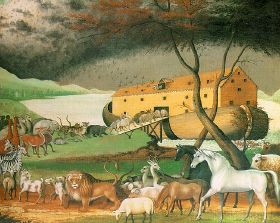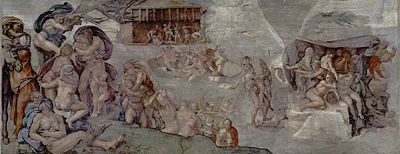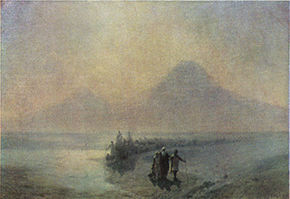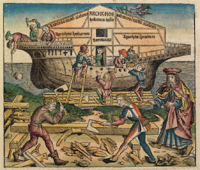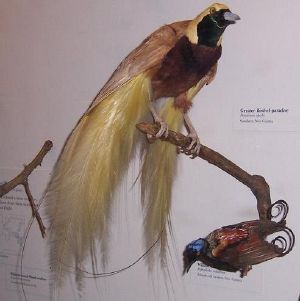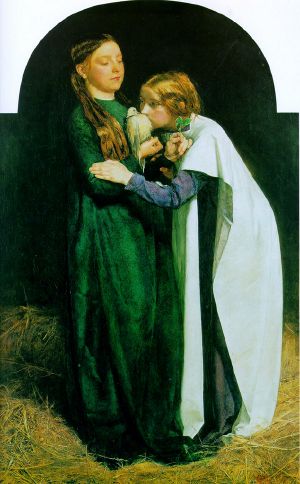Noah's Ark
According to Abrahamic religions, Noah's Ark was a vessel built at God's command to save Noah, his family, and a core stock of the world's animals from the Great Flood. The story is contained in the book of Genesis and in the Qur'an.
The story told in Genesis has been subject to extensive elaborations in the various Abrahamic traditions, mingling theoretical solutions to practical problems (e.g. how Noah might have disposed of animal waste) with allegorical interpretations (e.g. the Ark as a precursor of the Church, offering salvation to mankind).
By the 19th century, the growth of geology and biogeography as sciences meant that few natural historians felt able to justify a literal interpretation of the Ark story,[1] and biblical critics were turning their attention to its secular origins and purposes. Nevertheless, Biblical literalists today continue to take the Ark as test-case for their understanding of the Bible, and to explore the region of the mountains of Ararat in modern-day Turkey where Genesis says Noah's Ark came to rest.
Narrative
The story of Noah's Ark, according to chapters 6 to 9 in the Book of Genesis,[2] begins with God observing man's evil behavior and deciding to flood the earth and destroy all life. However, God found one good man, Noah, "a righteous man, blameless among the people of his time," and decided that he would carry forth the lineage of man. God told Noah to make an ark, and to bring with him his wife, and his sons Shem, Ham, and Japheth, and their wives. Additionally, he was told to bring examples of all animals and birds, male and female. In order to provide sustenance, he was told to bring and store food.
Noah and his family and the animals entered the Ark, and "the same day were all the fountains of the great deep broken up, and the windows of heaven were opened, and the rain was upon the earth forty days and forty nights." The flood covered even the highest mountains to a depth of more than twenty feet, and all creatures died; only Noah and those with him on the Ark were left alive.
After 150 days, the Ark came to rest on the mountains of Ararat. The waters continued to recede, and after about seventy more days the hilltops emerged. Noah sent out a raven which "went to and fro until the waters were dried up from the earth." Next, Noah sent a dove out, but it returned having found nowhere to land. After a further seven days, Noah again sent out the dove, and it returned with an olive leaf in its beak, and he knew that the waters had subsided. Noah waited seven days more and sent out the dove once more, and this time it did not return. Then he and his family and all the animals left the Ark, and Noah made a sacrifice to God, and God resolved that he would never again curse the ground because of man, and never again would He destroy all life on it in this manner.
In order to remember this promise, God put a rainbow in the clouds, saying, "Whenever I bring clouds over the earth and the rainbow appears in the clouds, I will see it and remember the everlasting covenant between God and all living creatures of every kind on the earth."
The Ark in later traditions
In Rabbinic tradition
The story of Noah and the Ark was subject to much discussion in later Jewish rabbinic literature. Noah's failure to warn others of the coming flood was widely seen as casting doubt on his righteousness—was he perhaps only righteous by the lights of his own evil generation? According to one tradition, he had in fact passed on God's warning, planting cedars one hundred and twenty years before the Deluge so that the sinful could see and be urged to amend their ways. In order to protect Noah and his family, God placed lions and other ferocious animals to guard them from the wicked who mocked them and offered them violence. According to one midrash, it was God, or the angels, who gathered the animals to the Ark, together with their food. As there had been no need to distinguish between clean and unclean animals before this time, the clean animals made themselves known by kneeling before Noah as they entered the Ark. A differing opinion said that the Ark itself distinguished clean from unclean, admitting seven of the first and two of the second.
Noah was engaged both day and night in feeding and caring for the animals, and did not sleep for the entire year aboard the Ark. The animals were the best of their species, and so behaved with utmost goodness. They abstained from procreation, so that the number of creatures that disembarked was exactly equal to the number that embarked. Yet Noah was lamed by the lion, rendering him unfit for priestly duties, and the sacrifice at the end of the voyage was therefore carried out by his son Shem. The raven created problems, refusing to go out of the Ark when Noah sent it forth and accusing the Patriarch of wishing to destroy its race. Nevertheless, as the commentators pointed out, God wished to save the raven, for its descendants were destined to feed the prophet Elijah.
Refuse was stored on the lowest of the Ark's three decks, humans and clean beasts on the second, and the unclean animals and birds on the top. A differing opinion placed the refuse in the utmost story, from where it was shoveled into the sea through a trapdoor. Precious stones, bright as midday, provided light, and God ensured that food was kept fresh. The giant Og, king of Bashan, was among those saved, but owing to his size had to remain outside, Noah passing him food through a hole cut into the wall of the Ark.[3][4][5]
In Christian tradition
Early Christian writers created elaborate allegorical meanings for Noah and the Ark: thus the First Epistle of Peter compares the salvation of those aboard the Ark through the waters of the Flood to the Christian saved through baptism,[6] and the equation of Ark and Church is still found in the Anglican rite of baptism, which asks God, "who of thy great mercy didst save Noah," to receive into the Church the infant about to be baptized. Early Christian artists frequently depicted Noah standing in a small box on the waves, symbolising God saving the Church as it persevered through turmoil.
St. Augustine of Hippo (354–430), in City of God, demonstrated that the dimensions of the Ark corresponded to the dimensions of the human body, which is the body of Christ, which is the Church.[7] St. Jerome (c. 347–420) called the raven, which was sent forth and did not return, the "foul bird of wickedness" expelled by baptism;[8] more enduringly, the dove and olive branch came to symbolize the Holy Spirit and the hope of salvation and, eventually, peace.
St. Hippolytus of Rome, (d. 235), seeking to demonstrate that "the ark was a symbol of the Christ who was expected," stated that it was built in three stories, the lowest for wild beasts, the middle for birds and domestic animals, and the top level for humans, and the male animals were separated from the females by sharp stakes, to help maintain the prohibition against cohabitation aboard the vessel. He adds that a door was built on the east side, that the bones of Adam were brought aboard together with gold, frankincense and myrrh, and that the Ark floated to and fro in the four directions on the waters, making the sign of the cross, before eventually landing on Mount Kardu "in the east, in the land of the sons of Raban, and the Orientals call it Mount Godash; the Arabians and Persians call it Ararat".[9]
On a more practical plane, Origen (c. 182–251), responding to a critic who doubted that the Ark could contain all the animals in the world, countered with a learned argument about cubits, holding that Moses, the traditional author of the book of Genesis, had been brought up in Egypt and would therefore have used the larger Egyptian cubit. He also fixed the shape of the Ark as a truncated pyramid, rectangular rather than square at its base, and tapering to a square peak one cubit on a side; it was not until the 12th century that it came to be thought of as a rectangular box with a sloping roof.[10]
In Islamic tradition
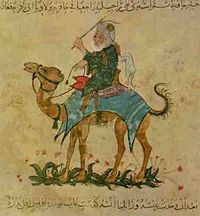
Noah (Nuh) is one of the five principal prophets of Islam, generally mentioned in connection with the fate of those who refuse to listen to the Word. References are scattered through the Qur'an, with the fullest account at surah 11:27–51, entitled "Hud."
In contrast to the Jewish tradition, which uses a term which can be translated as a "box" or "chest" to describe the Ark, surah 29:14 refers to it as a safina, an ordinary ship, and surah 54:13 as "a thing of boards and nails." Surah 11:44 says it settled on Mount Judi, identified by tradition with a hill near the town of Jazirat ibn Umar on the east bank of the Tigris in the province of Mosul in northern Iraq.
Abd al-Hasan Ali ibn al-Husayn Masudi (d. 956) says that the spot where it came to rest could be seen in his time. Masudi also says that the Ark began its voyage at Kufa in central Iraq and sailed to Mekka, where it circled the Kaaba, before finally traveling to Judi. Sura 11:41 says: "And he said, 'Ride ye in it; in the Name of God it moves and stays!'" Abdallah ibn 'Umar al-Baidawi, writing in the 13th century, takes this to mean that Noah said, "In the Name of God!" when he wished the Ark to move, and the same when he wished it to stand still.
The flood was sent by Allah in answer to Noah's prayer that this evil generation should be destroyed; yet as Noah was righteous he continued to preach, and seventy idolaters were converted and entered the Ark with him, bringing the total aboard to 78 humans (these seventy plus the eight members of Noah's own family). The seventy had no offspring, and all of post-flood humanity is descended from Noah's three sons. A fourth son (or a grandson, according to some) named Canaan was among the idolaters, and was drowned.
Baidawi gives the dimensions of the Ark as 300 cubits by 50 by 30, and explains that in the first of the three levels wild and domesticated animals were lodged, in the second the human beings, and in the third the birds. On every plank was the name of a prophet. Three missing planks, symbolising three prophets, were brought from Egypt by Og, son of Anak, the only one of the giants permitted to survive the Flood. The body of Adam was carried in the middle to divide the men from the women.
Noah spent five or six months aboard the Ark, at the end of which he sent out a raven. But the raven stopped to feast on carrion, and so Noah cursed it and sent out the dove, which has been known ever since as the friend of mankind. Masudi writes that God commanded the earth to absorb the water, and certain portions which were slow in obeying received salt water in punishment and so became dry and arid. The water which was not absorbed formed the seas, so that the waters of the flood still exist.
Noah left the Ark on the tenth day of Muharram, and he and his family and companions built a town at the foot of Mount Judi named Thamanin ("eighty"), from their number. Noah then locked the Ark and entrusted the keys to Shem. Yaqut al-Hamawi (1179–1229) mentions a mosque built by Noah which could be seen in his day, and Ibn Batutta passed the mountain on his travels in the 14th century. Modern Muslims, although not generally active in searching for the Ark, believe that it still exists on the high slopes of the mountain.[4][3]
In other traditions
The Mandaeans of the southern Iraqi marshes regard Noah as a prophet, while rejecting Abraham (and Jesus) as false prophets. In the version given in their scriptures, the ark was built of sandalwood from Jebel Harun and was cubic in shape, with a length, width and height of 30 gama (the length of an arm); its final resting place is said to be Egypt.
The Yazidi of the Sinjar mountains north of Mosul practice a unique blend of indigenous and Islamic beliefs. According to their Mishefa Reş, the Deluge occurred not once, but twice. The original Deluge is said to have been survived by a certain Na'umi, father of Ham, whose ark landed at a place called Ain Sifni, in the region of Mosul. Some time after this came the second flood, upon the Yezidis only, which was survived by Noah, whose ship was pierced by a rock as it floated above Mount Sinjar, then went on to land on Mount Judi as described in Islamic tradition.
The Bahá'í Faith, a religion founded in 19th century Persia by Bahá'u'lláh, states that the references to the Ark and the Flood in both the Bible and the Qur'an are symbolic.[11] In Bahá'í belief, only Noah's followers were spiritually alive, preserved in the ark of his teachings, as others were spiritually dead.[12][13] The Bahá'í scripture Kitáb-i-Íqán endorses the Islamic belief that Noah had a large number of companions, either 40 or 72, besides his family on the Ark, and that he taught for 950 years before the flood, though the years are not solar years and are symbolic.[14]
The Ark in scientific and critical scholarship
The Ark under scrutiny
The Renaissance saw a continued speculation that might have seemed familiar to Origen and Augustine: What of the Phoenix, which is unique, how could it come in as a pair? (A popular solution was that it contained male and female in itself.) And might the Sirens, which by their nature lure sailors to their doom, have been permitted on board? (The answer was no; they swam outside.) And the bird of paradise, which has no feet—did it therefore fly endlessly inside the Ark? Yet at the same time, a new class of scholarship arose, one which, while never questioning the literal truth of the Ark story, began to speculate on the practical workings of Noah's vessel from within a purely naturalistic framework. Thus in the 15th century, Alfonso Tostada gave a detailed account of the logistics of the Ark, down to arrangements for the disposal of dung and the circulation of fresh air, and the noted 16th-century geometrician Johannes Buteo calculated the ship's internal dimensions, allowing room for Noah's grinding mills and smokeless ovens, a model widely adopted by other commentators.[10]
By the 17th century, it was becoming necessary to reconcile the exploration of the New World and increased awareness of the global distribution of species with the older belief that all life had sprung from a single point of origin on the slopes of Mount Ararat. The obvious answer was that man had spread over the continents following the destruction of the Tower of Babel and taken animals with him, yet some of the results seemed peculiar: why had the natives of North America taken rattlesnakes, but not horses, wondered Sir Thomas Browne in 1646? "How America abounded with Beasts of prey and noxious Animals, yet contained not in that necessary Creature, a Horse, is very strange."[10]
Browne, who was among the first to question the notion of spontaneous generation, was a medical doctor and amateur scientist making this observation in passing. Biblical scholars of the time such as Justus Lipsius (1547–1606) and Athanasius Kircher (c.1601–80) were also beginning to subject the Ark story to rigorous scrutiny as they attempted to harmonize the Biblical account with natural historical knowledge. The resulting hypotheses were an important impetus to the study of the geographical distribution of plants and animals, and indirectly spurred the emergence of biogeography in the 18th century. Natural historians began to draw connections between climates and the animals and plants adapted to them. One influential theory held that the biblical Ararat was striped with varying climatic zones, and as climate changed, the associated animals moved as well, eventually spreading to repopulate the globe. There was also the problem of an ever-expanding number of known species: for Kircher and earlier natural historians, there was little problem finding room for all known animal species in the Ark, but by the time John Ray (1627–1705) was working, just several decades after Kircher, their number had increased dramatically. Incorporating the full range of animal diversity into the Ark story was becoming increasingly difficult, and by 1700 few natural historians could justify a literal interpretation of the Noah's Ark narrative.[1]
Secular biblical scholarship
- See also: documentary hypothesis
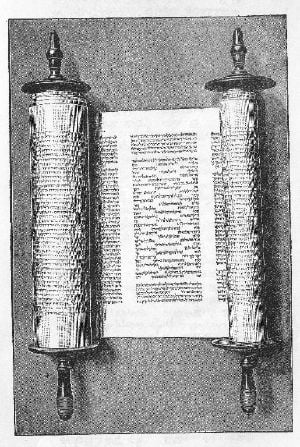
According to Jewish and Christian tradition, the Torah, including Genesis and the story of the Ark, was dictated by God to Moses, and for many centuries to question this belief was to risk ostracism or worse. But the intellectual revolution of the 17th and 18th centuries (the European Enlightenment) saw the rise of a secular biblical scholarship, one which treated the Bible as the product of human authors. The work of a century of these scholars was synthesized in 1886 by Julius Wellhausen in his Prolegomena zur Geschichte Israels ("Prolegomena to the History of Israel"), a book which did for biblical studies what Charles Darwin's Origin of Species had previously done for biology. The core of Wellhausen's documentary hypothesis, and a principle that is still the core of biblical scholarship today, is that the five books of the Pentateuch are a composite creation, and date in their final form from the latter half of the 1st millennium B.C.E.
Wellhausen posited four independent source texts, known for convenience as J, E, D and P. All were composed within the last millennium before Christ, with the final unified version dating from the Babylonian exile. Two of the four texts, J (short for Jahwist), and P, (the Priestly source), contributed to the Ark narrative, and their combination into a single narrative explains many confusions and inconsistencies which had puzzled commentators since the Middle Ages. Why, for example, does the story state twice over that mankind had grown corrupt but that Noah was to be saved (Gen 6:5–8; 6:11–13)? Was Noah commanded to take one pair of each clean animal into the Ark (Gen 6:19–20) or seven pairs (Gen 7:2–3)? Did the flood last forty days (Gen. 7:17) or a hundred and fifty days (Gen 7:24)? How could the raven that was sent out from the Ark and "went to and fro until the waters had subsided from the face of the earth" survive the two to three weeks involved (Gen 8:7)? Why does the narrative appear to have two logical end-points (Gen 8:20–22 and 9:1–17)?[15]
The Jahwist is held to be the earlier of the two texts, composed in the kingdom of Judah from even earlier texts and traditions soon after the separation of Judah and Israel c. 920 B.C.E. This narrative is the simpler story: God sends his flood (for forty days), Noah and his family and the animals are saved (seven pairs of each clean animal, a single pair for the unclean), Noah builds an altar and makes sacrifices, and God resolves never again to destroy the earth with a flood. The Jahwist source makes no mention of the covenant between God and Noah.[15]
The Priestly text is believed to have been composed by the Aaronid priests of the temple in Jerusalem after the fall of the northern kingdom of Israel in 722 B.C.E., with the specific purpose of countering certain points in the J text. The material from the Priestly source contains far more detail than the Jahwist—for example, the instructions for the building of the Ark, and the detailed chronology—and also provides the vital theological core of the story, the covenant between God and Noah at Gen 9:1–17, which introduces the peculiarly Jewish method of ritual slaughter and forms the quid pro quo for God's promise not to destroy the world again. It is the Priestly source which gives us the raven (the Jahwist has the dove) and the rainbow, and which introduces the windows of heaven and the fountains of the deep (the Jahwist simply says that it rained). All four texts now making up the Pentateuch were edited into their present form following the return from the Babylonian exile in the fifth century B.C.E.[15]
At a theological level, the theme of Yahweh's decision to administer an exacting punishment for man's wickedness, and his later promises never again to repeat such punishment, are typical of the Jahwist, who treat God as a human-like figure who appears in person in the narrative. The Priestly source, by contrast, presents God as distant and unapproachable except through the Aaronic priesthood. As a result, the Jahwist source allows Noah to sacrifice to Yahweh after the flood, and therefore requires seven pairs of each clean animal, while the Priestly source reduces this to a single pair, as no sacrifices can be made under priestly rules until Aaron, the first priest, appears in Exodus.
In recent decades the documentary hypothesis has been challenged by scholars who allocate far later dates for Biblical texts than those advanced by the older generation of scholars, and warn against accepting any text at face value. Thus minimalist scholars point to the strong strand of Mesopotamian myth in Genesis (the creation stories, the story of the Tower of Babel, and many individual elements within these stories) as indicative that the Ark story was written in Babylon, following the Babylonian conquest of Judah (587 B.C.E.). Faced with Babylonian stories about Babylonian gods creating and controlling the world (including a story about how the gods saved one man from a great flood), the exiled priests of Yahweh rewrote the myths of their conquerors to give primacy to Yahweh, effectively denying the power both of the Babylonians and of their divinities.[16] Umberto Cassuto, E. Nielsen and F.I. Andersen have all defended the unity of the Flood story, while Gordon Wenham (1978) has noted that the entire account is in the form of a single rhetorical figure known as a palistrophe, which could only have been composed as a unity.[17]
Mesopotamian flood stories
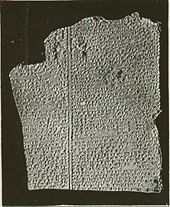
The majority of modern Biblical scholars accept the thesis that the Biblical flood story is linked to a cycle of Assyro-Babylonian mythology with which it shares many features. The Mesopotamian flood-myth had a very long currency—the last known retelling dates from the 3rd century B.C.E. A substantial number of the original Sumerian, Akkadian and Assyrian texts, written in cuneiform, have been recovered by archaeologists, but the task of recovering more tablets continues, as does the translation of extant tablets.
The earliest of these extant tablets, the epic of Atrahasis, can be dated by colophon (scribal identification) to the reign of Hammurabi's great-grandson, Ammi-Saduqa (1646–1626 B.C.E.). Written in Akkadian (the language of ancient Babylon), it tells how the god Enki warns the hero Atrahasis ("Extremely Wise") of Shuruppak to dismantle his house (which is made of reeds) and build a boat to escape a flood with which the god Enlil, angered by the noise of the cities, plans to wipe out mankind. The boat is to have a roof "like Apsu" (the underworld ocean of freshwater of which Enki is lord), upper and lower decks, and must be sealed with bitumen. Atrahasis boards the boat with his family and animals and seals the door. The storm and flood begin. Even the gods are afraid. "Bodies clog the river like dragonflies." After seven days the flood ends and Atrahasis offers sacrifices. Enlil is furious, but Enki, the friend of mankind, defies him - "I made sure life was preserved" - and eventually Enki and Enlil agree on other measures for controlling the human population. The story also exists in a later Assyrian version.[18]
The story of Ziusudra is told in the Sumerian language in the fragmentary Eridu Genesis, which can be dated from its script to the late 17th century B.C.E. It tells how Enki warns Ziusudra (meaning "he saw life," in reference to the gift of immortality given him by the gods), king of Shuruppak, of the gods' decision to destroy mankind with a flood—the passage describing why the gods have decided this is lost. Enki instructs Ziusudra to build a large boat—the text describing the instructions is also lost. After a flood of seven days, Ziusudra makes appropriate sacrifices and prostrations to An (sky-god) and Enlil (chief of the gods), and is given eternal life in Dilmun, the Sumerian Eden.[19]
The story of Utnapishtim (a translation of "Ziusudra" into Akkadian), an episode in the Babylonian Epic of Gilgamesh, is known from first millennium copies and is probably derived from the Atrahasis story.[20][21] Ellil, (the equivalent of Enlil), chief of the gods, wishes to destroy mankind with a flood. Utnapishtim, king of Shurrupak, is warned by the god Ea (equivalent to Enki) to tear down his house of reeds and use the materials to build an ark and load it with gold, silver, and the seed of all living creatures and all his craftsmen. After a storm lasting seven days, and a further twelve days on the waters, the ship grounds on Mount Nizir; after seven more days Utnapishtim sends out a dove, which returns, then a swallow, which also returns, and finally a raven, which does not come back. Utnapishtim then makes offerings (by sevens) to the gods, and the gods smell the roasting meat and gather "like flies." Ellil is angry that any human has escaped, but Ea upbraids him, saying, "How couldst thou without thought send a deluge? On the sinner let his sin rest, on the wrongdoer rest his misdeed. Forbear, let it not be done, have mercy, [That men perish not]." Utnapishtim and his wife are then given the gift of immortality and sent to dwell "afar off at the mouth of the rivers."[22]
In the 3rd century B.C.E. Berossus, a high priest of the temple of Marduk in Babylon, wrote a history of Mesopotamia in Greek for Antiochus Soter (323–261 B.C.E.). Berossus's Babyloniaka has not survived, but the 3rd/4th century Christian historian Eusebius retells from it the legend of Xisuthrus, the Greek version of Ziusudra, and essentially the same story. Eusebius concludes that the vessel was still to be seen "in the Corcyræan Mountains of Armenia; and the people scrape off the bitumen, with which it had been outwardly coated, and make use of it by way of an alexipharmic and amulet."[23]
Biblical literalism and the Ark
Many Orthodox Jews and conservative Christians are believers in Biblical inerrancy, the concept that the Bible, as the word of God, is without error, but must be interpreted properly in order to be understood correctly. They also tend to trust in traditions regarding the composition of the Bible (see, e.g. the historical-grammatical method, Sacred Tradition and Midrash). Those who follow these Biblical hermeneutical methods, therefore, generally accept the traditional Jewish belief that the Ark narrative in Genesis was written by Moses. There is less agreement on when Moses lived, and thus on when the Ark story was written—various dates have been proposed ranging from the 16th century B.C.E. to the late 13th century B.C.E.
For the date of the Flood, literalists rely on interpretation of the genealogies contained in Genesis 5 and 11. Archbishop Ussher, using this method in the 17th century, arrived at 2349 B.C.E., and this date still has acceptance among many. A more recent Christian fundamentalist scholar, Gerhard F. Hasel, however, summarizing the current state of thought in the light of the various Biblical manuscripts (the Masoretic text in Hebrew, various manuscripts of the Greek Septuagint), and differences of opinion over their correct interpretation, demonstrated that this method of analysis can date the flood only within a range between 3402 and 2462 B.C.E.[24] Other opinions, based on other sources and methodologies, lead to dates outside even this bracket—the deuterocanonical Book of Jubilees, for example, providing a date equivalent to 2309 B.C.E.
Literalists explain apparent contradiction in the Ark narrative as the result of the stylistic conventions adopted by an ancient text: thus the confusion over whether Noah took seven pairs or only one pair of each clean animal into the Ark is explained as resulting from the author (Moses) first introducing the subject in general terms—seven pairs of clean animals—and then later, with much repetition, specifying that these animals entered the Ark in twos. Literalists see nothing puzzling in the reference to a raven—why should Noah not release a raven?—nor do they see any sign of alternative endings.
Apart from questions of date, authorship, and textual integrity, literalists devote much attention to technical matters such as the identity of "gopher wood" and details of the Ark's construction. The following sets out some of the more commonly discussed topics:
- Gopher wood: Gen 6:14 states that Noah built the Ark of גפר (gofer, more commonly gopher) wood, a word not otherwise known in the Bible or in Hebrew. The Jewish Encyclopedia believes it was most likely a translation of the Babylonian "gushure iş erini" (cedar-beams), or the Assyrian "giparu" (reed).[25] The Greek Septuagint (3rd–1st centuries B.C.E.) translated it as ξύλων τετραγώνων ("xylon tetragonon"), "squared timber."[26] Similarly, the Latin Vulgate (5th century AD) rendered it as "lignis levigatis," or "smoothed (possibly planed) wood." Older English translations, including the King James Version (17th century), simply leave it untranslated. Many modern translations tend to favor cypress (although the word for "cypress" in Biblical Hebrew is erez), on the basis of a mistaken etymology based on phonetic similarities, while others favor pine or cedar. Recent suggestions have included a lamination process, or a now-lost type of tree, or a mistaken transcription of the word kopher (pitch), but there is no consensus.[27]
- Seaworthiness: The Ark is described as 300 cubits long, the cubit being a unit of measurement from elbow to outstretched fingertip. The ancient cubit was from 17.5 inches to 21.5 inches, giving a length in the range 437.5 feet (133 m) to 537.5 feet (164 m);[28] literalist websites seem to agree that the Ark was approximately 450 feet (137 m)long. This is considerably longer than the schooner Wyoming, launched in 1909 and the longest documented wooden-hulled vessel ever built: it measured only 329.5 feet (100 m) and needed iron cross-bracing to counter warping and a steam pump to handle a serious leak problem. "The construction and use histories of [late 19th-century wooden European] ships indicated that they were already pushing or had exceeded the practical limits for the size of wooden ships."[29]
- Capacity and logistics: According to Ark dimensions commonly accepted by literalists, the Ark would have had a gross volume of about 1.5 million cubic feet (40,000 m³), a displacement a little less than half that of the Titanic at about 22,000 tons, and total floor space of around 100,000 square feet (9,300 m²).[30] The question of whether it could have carried two (or more) specimens of the various species (including those now extinct), plus food and fresh water, is a matter of much debate, even bitter dispute, between literalists and their opponents. While some literalists hold that the Ark could have held all known species, a more common position today is that the Ark contained "kinds" rather than species—for instance, a male and female of the cat "kind" rather than representatives of tigers, lions, cougars, etc.[31] The many associated questions include whether eight humans could have cared for the animals while also sailing the Ark, how the special dietary needs of some of the more exotic animals could have been catered for, how the creatures could have been prevented from preying on each other, questions of lighting, ventilation, and temperature control, hibernation, the survival and germination of seeds, the position of freshwater and saltwater fish, the question of what the animals would have eaten immediately after leaving the Ark, how they traveled (or were gathered) from all over the world to board the Ark and how they could have returned to their far-flung habitats across the Earth's bare, flood-devastated terrain, and how two or a few members of a species could have provided enough genetic variety to avoid inbreeding and reconstitute a healthy population. The numerous literalist websites, while agreeing that none of these problems is insurmountable, give varying answers on how to resolve them.
The search for Noah's Ark
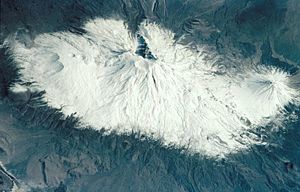
Believers in the historicity of the Genesis account feel that finding the Ark would validate their views on a whole range of matters, from geology to evolution. "If the flood of Noah indeed wiped out the entire human race and its civilization, as the Bible teaches, then the Ark constitutes the one remaining major link to the pre-flood World. No significant artifact could ever be of greater antiquity or importance.... [with] tremendous potential impact on the creation-evolution (including theistic evolution) controversy."[32]
Searches have concentrated on Mount Ararat itself, although Genesis actually refers only to the "mountains of Ararat." The Durupinar site, near but not on Ararat, and much more accessible, attracted attention in the 1980s and 1990s; In early 2004 a Honolulu businessman traveled to Washington DC to “announce with great fanfare” a planned expedition to investigate a site he called the Ararat anomaly but National Geographic later concluded it may have been an ineffective stunt to “persuade the Turkish government into granting him a permit” that “few expeditions have actually obtained.”;[33] and in 2006 there was brief flurry of interest when an expedition reported a potential site in Iran. Despite all these efforts, no physical remains have been found.
More controversially, in the 1980s, adventurer and self-styled archaeologist Ron Wyatt and his colleague David Fasold claimed to have discovered Noah's Ark at Durupinar, some 20 miles from Mt Ararat.[34]
See also
- Black Sea deluge theory
- Deluge (prehistoric)
- Deluge (mythology)
- Deucalion
- Flood geology
- Durupinar
- Searches for Noah's Ark
- Wives aboard the Ark
- Ron Wyatt
- David Fasold
- Evan Almighty
- Epic of Gilgamesh
ReferencesISBN links support NWE through referral fees
- Bailey, Lloyd R. (1989). Noah, the Person and the Story. South Carolina: University of South Carolina Press. ISBN 0-87249-637-6.
- Best, Robert M. (1999). Noah's Ark and the Ziusudra Epic. Fort Myers, Florida: Enlil Press. ISBN 0-9667840-1-4.
- Brenton, Sir Lancelot C.L. [1851] (1986). The Septuagint with Apocrypha: Greek and English (reprint). Peabody: Hendrickson Publishers. ISBN 0-913573-44-2.
- Tigay, Jeffrey H., (1982). The Evolution of the Gilgamesh Epic. University of Pennsylvania Press, Philadelphia. ISBN 0-8122-7805-4.
- Woodmorappe, John (1996). Noah's Ark: A Feasibility Study. El Cajon, CA: Institute for Creation Research. ISBN 0-932766-41-2.
- Young, Davis A. (1995). The Biblical Flood. Grand Rapids, MI: Eerdmans Publishing Co.. ISBN 0-8028-0719-4.
External links
- In the Beginning: Compelling Evidence for Creation and the Flood, Online Book at Center for Scientific Creation
- World Wide Flood's Naval Architects Professional ship designers consider Noah's Ark design.
- Depictions of Noah's Ark through history at World Wide Flood
- Problems with a Global Flood at TalkOrigins Archive
- Problems with a Global Flood? Response to the above
- Some Jewish Opinions on the Ark at Chabad.org
- Parallels between flood myths Comparison of equivalent lines in six ancient versions of the flood story
- Noah's Ark and Creation Science
- Noah's Flood Questions and Answers at Answers in Genesis
- History of the Collapse of "Flood Geology" and a Young Earth, adapted from the book The Biblical Flood by Davis A. Young
Notes
- ↑ 1.0 1.1 Browne, Janet (1983). The Secular Ark: Studies in the History of Biogeography. New Haven & London: Yale University Press. ISBN 0-300-02460-6.
- ↑ Book of Genesis (Revised Standard Version).
- ↑ 3.0 3.1 McCurdy, JF, Bacher, W, Seligsohn, M, Hirsch, EG, & Montgomery, MW (2002). Jewish Encyclopedia: Noah. JewishEncyclopedia.com. Retrieved 2007-06-27.
- ↑ 4.0 4.1 Jastrow, M, McCurdy, JF, Jastrow, M, Ginzberg, L & McDonald, DB (2002). Jewish Encyclopedia: Ark of Noah. JewishEncyclopedia.com. Retrieved 2007-06-27.
- ↑ Hirsch, EG, Muss-Arnolt, W & Hirschfeld, H (2002). Jewish Encyclopedia: The Flood. JewishEncyclopedia.com. Retrieved 2007-06-27.
- ↑ 1 Peter.
- ↑ Schaff, P (1890). St. Augustin's City of God and Christian Doctrine, Chapter 26.—That the Ark Which Noah Was Ordered to Make Figures In Every Respect Christ and the Church. The Christian Literature Publishing Company. Retrieved 2007-06-27.
- ↑ Schaff, P (1892). Jerome: The Principal Works of St. Jerome, Letter LXIX. To Oceanus.. The Christian Literature Publishing Company. Retrieved September 27, 2007.
- ↑ Knight, K (2007). Fragments from Commentaries on Various Books of Scripture. New Advent. Retrieved 2007-06-27.
- ↑ 10.0 10.1 10.2 Cohn, Norman (1996). Noah's Flood: The Genesis Story in Western Thought. New Haven & London: Yale University Press. ISBN 0-300-06823-9.
- ↑ From a letter written on behalf of Shoghi Effendi, October 28, 1949: Bahá'í News, No. 228, February 1950, p. 4. Republished in Compilations (1983). in Hornby, Helen (Ed.): Lights of Guidance: A Bahá'í Reference File. Bahá'í Publishing Trust, New Delhi, India, p. 508. ISBN 8185091463.
- ↑ Poirier, Brent. The Kitab-i-Iqan: The key to unsealing the mysteries of the Holy Bible. Retrieved 2007-06-25.
- ↑ Shoghi Effendi (1971). Messages to the Bahá'í World, 1950–1957. Wilmette, Illinois, USA: Bahá'í Publishing Trust, p. 104. ISBN 0877430365.
- ↑ From a letter written on behalf of Shoghi Effendi to an individual believer, November 25, 1950. Published in Compilations (1983). in Hornby, Helen (Ed.): Lights of Guidance: A Bahá'í Reference File. Bahá'í Publishing Trust, New Delhi, India, p. 494. ISBN 8185091463.
- ↑ 15.0 15.1 15.2 Friedman, Richard Elliot (2003). The Bible with Sources Revealed: A new view into the five books of Moses. New York: Harper SanFrancisco. ISBN 0-06-073065-X. . Cite error: Invalid
<ref>tag; name "Friedman" defined multiple times with different content - ↑ For an on-line exposition of the minimalist position, including a brief overview of minimalist views of the Ark story, see Athas, G (1999). 'Minimalism' The Copenhagen School of Thought in Biblical Studies. John Mark Ministries. Retrieved September 27, 2007.
- ↑ Gordon Wenham, "The Coherence of the Flood Narrative," Vestus Testamentum, 1978. See Wenham's footnotes for references to Cassuto and others.
- ↑ Webster, M (2005). The Story of Atrahasis. Grand Valley State University. Retrieved 2007-06-27.
- ↑ Kramer, SN (1961). Sumerian Mythology: Chapter IV. Miscellaneous Myths. The internet sacred text archive. Retrieved September 27, 2007.
- ↑ Overview of Mesopotamian flood myths. University of Tennessee, Frank H. McClung Museum. Retrieved September 27, 2007.
- ↑ Tigay, Jeffrey H., (1982). The Evolution of the Gilgamesh Epic. University of Pennsylvania Press, Philadelphia. ISBN 0-8122-7805-4.
- ↑ Anonymous (1960). The Epic of Gilgamesh: An English Version with an Introduction. Penguin Classics.
- ↑ Best, RM (199). Noah's Ark and the Ziusudra Epic: Sumerian Origins of the Flood Myth. Eisenbrauns. ISBN 978-0966784015.
- ↑ Hasel, GF (1980). THE MEANING OF THE CHRONOGENEALOGIES OF GENESIS 5 AND 11. Origins 7 (2): 53–70. Retrieved September 27, 2007.
- ↑ Hirsch, EG & Hyvernat, H (2002). The Jewish Encyclopedia: Goper-Wood. The Jewish Encyclopedia. Retrieved September 27, 2007.
- ↑ Brenton, Sir Lancelot C.L. [1851] (1986). The Septuagint with Apocrypha: Greek and English (reprint). Peabody: Hendrickson Publishers. ISBN 0-913573-44-2.
- ↑ Taylor, Paul (2001). What is “Gopher Wood”?. Eden Communications. Retrieved September 27, 2007.
- ↑ biblestudy.org
- ↑ Gould, R (2001). Asia's Undersea Archeology. Public Broadcasting System. Retrieved 2007-06-27.
- ↑ Mendez, AC. How Big was Noah's Ark. biblestudy.org. Retrieved September 27, 2007.
- ↑ Sarfati, J (2007). Variation and natural selection versus evolution. Answers in Genesis. Retrieved September 27, 2007.
- ↑ Morris, John (2007). Noah's Ark the Search Goes On. Institute for Creation Research. Retrieved September 27, 2007.
- ↑ Lovgren, S (2004). Noah's Ark Quest Dead in Water—Was It a Stunt?. National Geographic. Retrieved September 27, 2007.
- ↑ Fasold, David (1988). The Ark of Noah. New York: Wynwood Press.
Credits
New World Encyclopedia writers and editors rewrote and completed the Wikipedia article in accordance with New World Encyclopedia standards. This article abides by terms of the Creative Commons CC-by-sa 3.0 License (CC-by-sa), which may be used and disseminated with proper attribution. Credit is due under the terms of this license that can reference both the New World Encyclopedia contributors and the selfless volunteer contributors of the Wikimedia Foundation. To cite this article click here for a list of acceptable citing formats.The history of earlier contributions by wikipedians is accessible to researchers here:
The history of this article since it was imported to New World Encyclopedia:
Note: Some restrictions may apply to use of individual images which are separately licensed.
